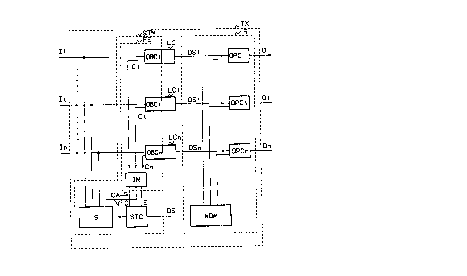Some of the information on this Web page has been provided by external sources. The Government of Canada is not responsible for the accuracy, reliability or currency of the information supplied by external sources. Users wishing to rely upon this information should consult directly with the source of the information. Content provided by external sources is not subject to official languages, privacy and accessibility requirements.
Any discrepancies in the text and image of the Claims and Abstract are due to differing posting times. Text of the Claims and Abstract are posted:
| (12) Patent: | (11) CA 2064648 |
|---|---|
| (54) English Title: | PROTECTION ARRANGEMENT FOR AN OPTICAL TRANSMITTER/RECEIVER DEVICE |
| (54) French Title: | DISPOSITIF DE PROTECTION POUR EMETTEUR-RECEPTEUR OPTIQUE |
| Status: | Expired and beyond the Period of Reversal |
| (51) International Patent Classification (IPC): |
|
|---|---|
| (72) Inventors : |
|
| (73) Owners : |
|
| (71) Applicants : |
|
| (74) Agent: | SMART & BIGGAR LP |
| (74) Associate agent: | |
| (45) Issued: | 1998-04-14 |
| (22) Filed Date: | 1992-04-01 |
| (41) Open to Public Inspection: | 1992-10-03 |
| Examination requested: | 1994-11-14 |
| Availability of licence: | N/A |
| Dedicated to the Public: | N/A |
| (25) Language of filing: | English |
| Patent Cooperation Treaty (PCT): | No |
|---|
| (30) Application Priority Data: | ||||||
|---|---|---|---|---|---|---|
|
This protection arrangement protects an optical
transmitter device (TX) with n optical transmit circuits
(LCl/LCn) or an optical receiver device (RX) with n optical
receive circuits (RXl/RXn). It includes fault evaluating
means (FE) to detect a defective transmit/receiver circuit
a spare transmit (STC)/receive (SRC) circuit and switching
means (S, Sl) upon detection of a defective
transmitter/receiver circuit by the fault evaluating means
the latter controls the spare circuit and the switching
means which then bypass the defective circuit by the spare
circuit.
Dispositif destiné à protéger un émetteur optique (TX) comportant n circuits d'émission optique (LCl/LCn) ou un récepteur optique (RX) comportant n circuits de réception optique (RXl/RXn). Le dispositif comprend un moyen d'évaluation de défaillance (FE) afin de détecter un circuit émetteur/récepteur défectueux, un circuit émetteur (STC)/récepteur (SRC) de rechange et un moyen de commutation (S, Sl). Lorsque le moyen d'évaluation de défaillance détecte un circuit émetteur/récepteur défectueux, il commande le circuit de rechange et le moyen de commutation, lequel contourne alors le circuit défectueux au moyen du circuit de rechange.
Note: Claims are shown in the official language in which they were submitted.
Note: Descriptions are shown in the official language in which they were submitted.

2024-08-01:As part of the Next Generation Patents (NGP) transition, the Canadian Patents Database (CPD) now contains a more detailed Event History, which replicates the Event Log of our new back-office solution.
Please note that "Inactive:" events refers to events no longer in use in our new back-office solution.
For a clearer understanding of the status of the application/patent presented on this page, the site Disclaimer , as well as the definitions for Patent , Event History , Maintenance Fee and Payment History should be consulted.
| Description | Date |
|---|---|
| Inactive: IPC expired | 2013-01-01 |
| Inactive: IPC expired | 2013-01-01 |
| Inactive: IPC from MCD | 2006-03-11 |
| Time Limit for Reversal Expired | 2003-04-01 |
| Letter Sent | 2002-04-02 |
| Grant by Issuance | 1998-04-14 |
| Pre-grant | 1997-12-12 |
| Inactive: Final fee received | 1997-12-12 |
| Notice of Allowance is Issued | 1997-11-03 |
| Notice of Allowance is Issued | 1997-11-03 |
| Letter Sent | 1997-11-03 |
| Inactive: Application prosecuted on TS as of Log entry date | 1997-10-28 |
| Inactive: Status info is complete as of Log entry date | 1997-10-28 |
| Inactive: IPC assigned | 1997-09-25 |
| Inactive: IPC assigned | 1997-09-25 |
| Inactive: IPC removed | 1997-09-25 |
| Inactive: First IPC assigned | 1997-09-25 |
| Inactive: Approved for allowance (AFA) | 1997-09-19 |
| Request for Examination Requirements Determined Compliant | 1994-11-14 |
| All Requirements for Examination Determined Compliant | 1994-11-14 |
| Application Published (Open to Public Inspection) | 1992-10-03 |
There is no abandonment history.
The last payment was received on 1998-03-23
Note : If the full payment has not been received on or before the date indicated, a further fee may be required which may be one of the following
Please refer to the CIPO Patent Fees web page to see all current fee amounts.
| Fee Type | Anniversary Year | Due Date | Paid Date |
|---|---|---|---|
| Final fee - standard | 1997-12-12 | ||
| MF (application, 6th anniv.) - standard | 06 | 1998-04-01 | 1998-03-23 |
| MF (patent, 7th anniv.) - standard | 1999-04-01 | 1999-03-18 | |
| MF (patent, 8th anniv.) - standard | 2000-04-03 | 2000-03-13 | |
| MF (patent, 9th anniv.) - standard | 2001-04-02 | 2001-03-19 |
Note: Records showing the ownership history in alphabetical order.
| Current Owners on Record |
|---|
| ALCATEL N.V. |
| Past Owners on Record |
|---|
| DENIS JULIEN GILLES MESTDAGH |
| INGRID ZULMA BENOIT VAN DE VOORDE |